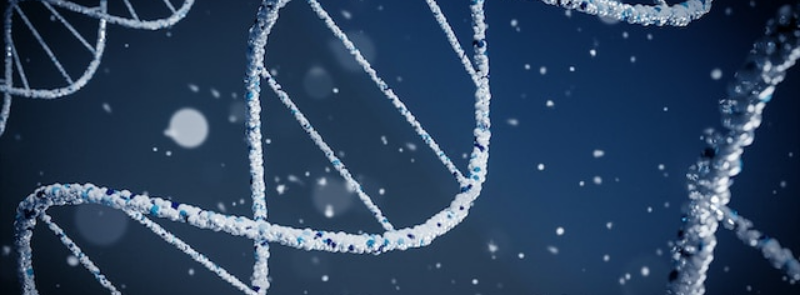
When It Occurs
Every April 25th
Official Website
Timeline
Days Passed (933)
# Hashtags
#NationalDNADay #HumanGenome
Since 2003, on the 25th of April each year, scientists, biologists, and genetics enthusiasts unite to commemorate National DNA Day. This observance marks the celebration of the discovery and ongoing research into DNA, as well as the scientific breakthroughs that have facilitated significant progress. Spearheaded annually by the Human Genome Research Institute, National DNA Day aims to inspire individuals to delve into the science that unveils their genetic uniqueness.
The History of DNA and Its Discovery
DNA, or deoxyribonucleic acid, is the hereditary material in all living organisms, carrying the genetic instructions used in the growth, development, functioning, and reproduction of all life forms. The discovery of the DNA double helix was a groundbreaking moment in biology, revolutionizing our understanding of genetics and heredity.
On April 25, 1953, James Watson and Francis Crick published their groundbreaking paper in the journal Nature, describing the double helix structure of DNA. Their model, which they famously built using cardboard and metal pieces, showed how DNA molecules are composed of two strands that twist around each other, with pairs of nucleotides forming the rungs of the ladder-like structure. This discovery laid the foundation for modern genetics, opening the door to countless advances in medicine, biotechnology, and evolutionary biology.
The Human Genome Project
The Human Genome Project (HGP) was an international research initiative aimed at mapping and sequencing the entire human genome, the complete set of DNA in a human being. The project began in 1990 and was completed in April 2003, two years ahead of schedule. The HGP provided scientists with a comprehensive reference of human genetic material, allowing for greater understanding of genetic diseases, human variation, and the complex interplay between genes and the environment.
The completion of the Human Genome Project marked a significant achievement in science, providing a roadmap for studying the genetic basis of diseases, developing targeted therapies, and advancing personalized medicine. National DNA Day was established by the National Human Genome Research Institute (NHGRI) in 2003 to commemorate the completion of the HGP and to educate the public about genetics and genomics.
The Importance of National DNA Day
National DNA Day serves as a reminder of the incredible advances in genetics and genomics over the past several decades. It is a day to celebrate the contributions of scientists and researchers who have expanded our understanding of DNA and its role in life. The day also aims to educate the public about the significance of genetics in everyday life and to inspire the next generation of scientists and researchers.
Key Objectives of National DNA Day:
-
Promoting Genetic Literacy: The day encourages public awareness and understanding of genetics and genomics. By making scientific knowledge accessible, National DNA Day helps people better understand the impact of genetics on health, disease, and society.
-
Celebrating Scientific Achievement: National DNA Day celebrates the milestones in genetic research, particularly the discovery of the DNA double helix and the completion of the Human Genome Project. It highlights the importance of continued research in genetics and the ongoing efforts to unlock the mysteries of the genome.
-
Inspiring Future Scientists: National DNA Day is an opportunity to engage students and young people in the field of genetics. Through educational programs, school activities, and public events, the day aims to inspire curiosity and interest in the sciences.
-
Advancing Personalized Medicine: The day also underscores the growing importance of genomics in medicine. With advances in genetic testing and personalized medicine, healthcare is becoming increasingly tailored to individual genetic profiles, leading to more effective treatments and better patient outcomes.
How to Celebrate National DNA Day
-
Learn About Genetics: Take the time to learn more about DNA, genetics, and genomics. There are many resources available, including online courses, documentaries, books, and articles that can help deepen your understanding of these fascinating topics.
-
Participate in Educational Events: Many schools, universities, and research institutions host events on National DNA Day, including lectures, workshops, and interactive exhibits. These events provide an opportunity to learn from experts in the field and engage with cutting-edge research.
-
Conduct a DNA Experiment: If you have access to a laboratory or educational kit, try conducting a simple DNA extraction experiment. Extracting DNA from fruits like strawberries or bananas is a popular classroom activity that demonstrates the physical presence of DNA.
-
Explore Your Ancestry: Consider using a DNA testing service to explore your ancestry and genetic heritage. These services can provide insights into your family’s origins, genetic traits, and even potential health risks.
-
Support Genetic Research: Consider donating to or volunteering with organizations that support genetic research and education. Your contributions can help advance scientific discovery and improve public understanding of genetics.
-
Share on Social Media: Use the hashtag #DNADay to share your experiences, learnings, and thoughts about genetics and DNA on social media. Engaging with the online community can help spread awareness and encourage others to explore the world of genetics.
Fun Facts About DNA
-
Universal Code: DNA is found in all living organisms, from the smallest bacteria to the largest mammals. The genetic code is universal, meaning that the same sequences of DNA code for the same amino acids in nearly all organisms.
-
Length of DNA: If the DNA in a single human cell were stretched out, it would be about 2 meters long. In the entire human body, there are approximately 37 trillion cells, meaning that the total length of DNA in your body could stretch to the sun and back hundreds of times.
-
Genetic Similarity: Humans share about 99.9% of their DNA with every other human being, and approximately 98% of their DNA with chimpanzees. Surprisingly, we even share about 50% of our DNA with bananas!
-
DNA Sequencing: Modern DNA sequencing technology has made it possible to sequence an entire human genome in just a few days, compared to the years it took during the Human Genome Project.
The Legacy of National DNA Day
National DNA Day is a celebration of scientific achievement and the ongoing quest to understand the fundamental building blocks of life. It recognizes the importance of genetics and genomics in shaping our understanding of biology, medicine, and evolution. The day also serves as an inspiration for future generations of scientists, encouraging them to explore the wonders of DNA and contribute to the ongoing advances in genetic research.
Whether you’re a student, educator, scientist, or simply someone with a curiosity about the natural world, National DNA Day offers an opportunity to engage with the fascinating science of genetics and to appreciate the profound impact that DNA has on our lives.


